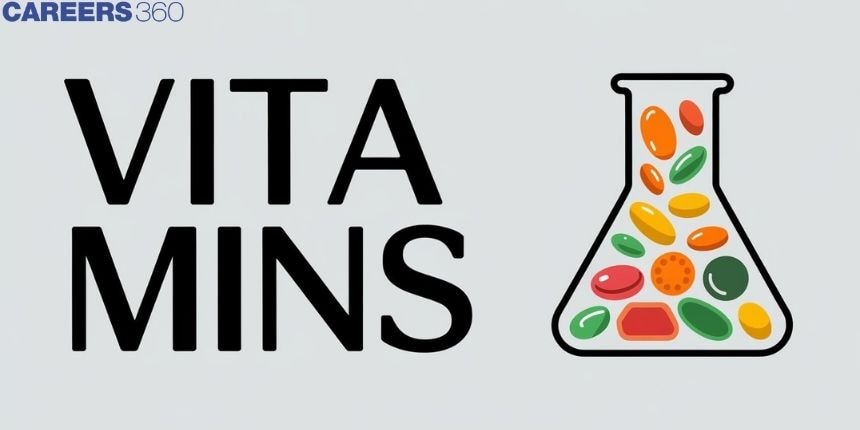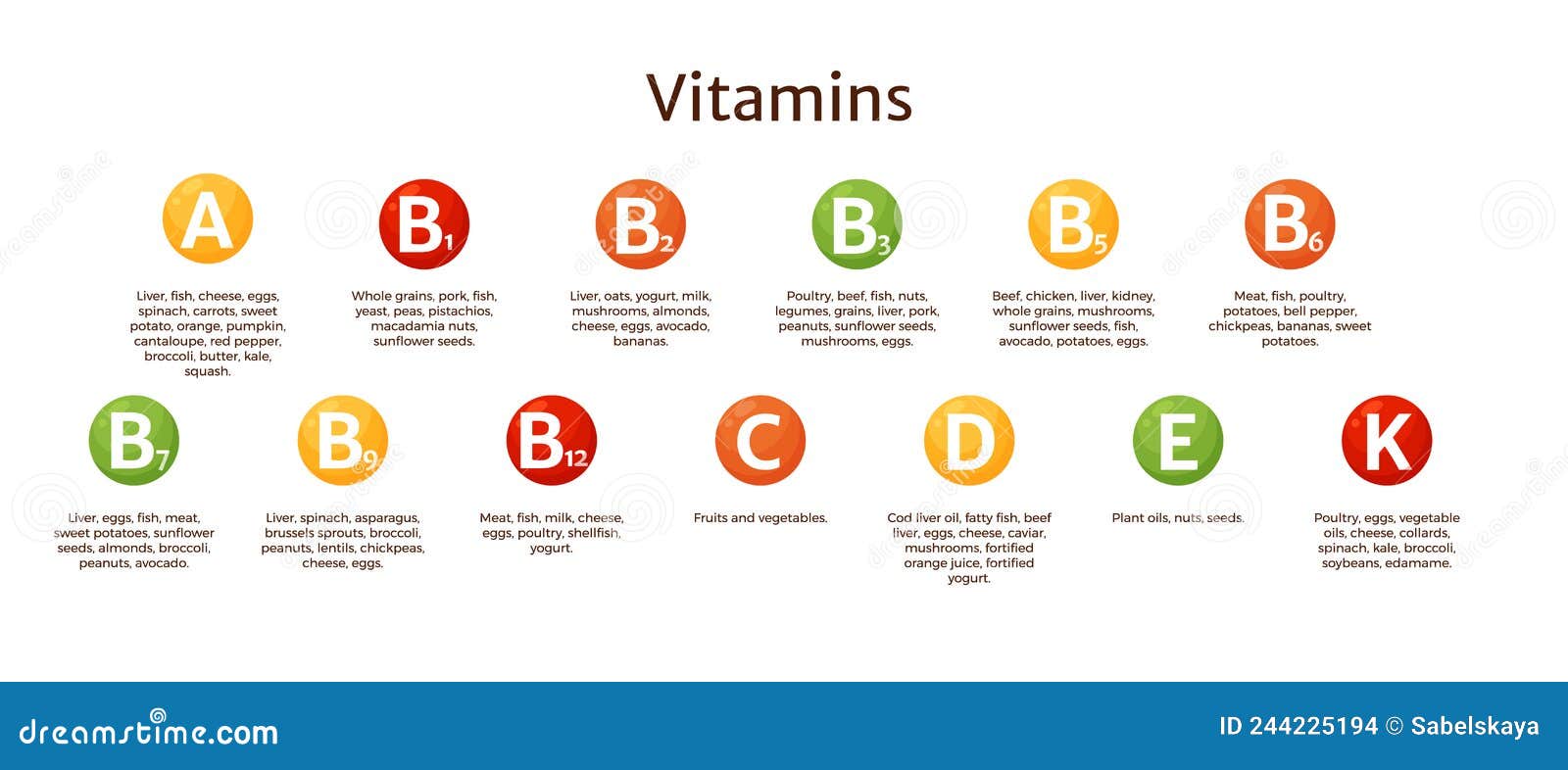Vitamins
Vitamins form a significant part in the context of our health. They take part in many functions of our bodies: starting with support to our immune system and ending with the production of energy. Principally, these organic compounds are classified into two main classes: fat-soluble and water-soluble vitamins. Though these are very essential, many people do not seem to know the types of vitamins, their supply through diet, and the after-effects of deficiency. This may result in an inadequate consumption of nutrients and could be the cause of many health-related problems
This Story also Contains
- Understanding Vitamins
- Classification of Vitamins based on their solubility
- Classification and Food Sources of Vitamins
- Real-Life Applications of Vitamins
- Some Solved Examples
- Summary

Today, more than ever before, such knowledge is necessary when fast foods and packet snacks dominate diets. Many people do not even think about including a range of fruits, vegetables, whole grains, and proteins in their diet, and it can lead to deficiencies. Here's an example: While vitamin D was considered a "sunshine vitamin" with a role in maintaining bone health, it's also important for having a good mood and healthy immunity. On the other hand, it has been shown that people are not consuming enough daily intake of vitamin C, yet it is best known as an antioxidant and performs collagen synthesis.
Understanding Vitamins
Vitamins are organic materials that the body requires for proper metabolism and which are only required in trace amounts. There are 13 known human vitamins that have been established to be essential for good health and another handful of substances recognized to have some vitamin-like activities. All the vitamins do have unique roles to play in maintaining a healthy body and supporting some physiological functions in the human body. The human body cannot make most vitamins, except for a few exceptions, thus the need for the vitamins to be part of the diet or taken as a dietary supplement.
It has been observed that certain organic compounds are required in small amounts in our diet but their deficiency causes specific diseases. These compounds are called vitamins.
- They are the chemical substances that are needed in small amounts for the growth of human beings.
- They can’t be synthesized in our bodies and therefore need to be taken from outsourced.
- Their deficiency can cause one or other types of diseases.
Type of Vitamins, their sources and functions:

Diseases caused due to deficiency of various vitamins:


Classification of Vitamins based on their solubility
1. Fat-soluble vitamins:
These are vitamins A, D, E, and K. They are stored in the body's fatty tissues and the liver. They require dietary fat for absorption, and when taken to excess, they will accumulate in the body and result in toxicity.
2. Water-soluble vitamins:
This group includes the B vitamins and vitamin C. Since they are, in fact, fat-soluble vitamins, they dissolve in water and are hence not stored inside the body; their intake should, therefore, be frequent enough to keep up the proper levels. Excess amounts, however, just get excreted via urine and hence rather are not prone to toxicity.
The various vitamins also perform some specified functions, such as giving support to immune functions, helping along the metabolism of energy, and facilitating healthy skin and vision. Their deficiency, therefore, may cause quite a number of health problems. Again, this very visibly states the fact that a balanced diet with a variety of food sources is so important.
Classification and Food Sources of Vitamins
Vitamins are primarily classified based on their sources and functions into two major groups. These are:
Fat-Soluble Vitamins
Vitamin A: Good for vision, immune function, and skin. Foods providing this vitamin include liver, carrots, and leafy green vegetables.
Vitamin D: Sometimes called the "sunshine vitamin," it helps your body absorb calcium for healthier bones. Your body can make it when your skin is exposed to sunlight, but you also get it from foods that have been fortified with it, like milk, cheese, and fatty fish.
Vitamin E: This is an antioxidant that protects the cells from damage. It is naturally found in nuts, seeds, and vegetable oils.
Vitamin K: Needed for blood clotting and for bones. It occurs naturally in green leafy vegetables and fermented foods.
Water-Soluble Vitamins
Vitamin B1 (Thiamin): Plays a Crucial Role in Energy Metabolism and Correct Nerve Functioning: Found naturally in whole grains, pork, and legumes.
Vitamin B2 (Riboflavin): Needed in the process of turning carbohydrates into energy and maintaining the health of the skin. It is acquired from milk, eggs, and green vegetables.
Vitamin B3 (Niacin): Aids digestion and gives good, healthy skin. It is obtained from meat, fish, and whole grains.
Vitamin C: The antioxidant, if taken in adequate amounts, promotes healthy skin through the production of collagen, apart from improving immune function. Its rich sources include citrus fruits, berries, and bell peppers.
Each of the vitamins has some crucial functions in the body, and their deficiency may potentially give rise to serious health issues. Lack of vitamin C can give rise to scurvy, and the lack of vitamin D causes rickets in children and osteomalacia in adults.
Real-Life Applications of Vitamins
Their relevance extends beyond nutrition into health promotion and public health. Knowing about vitamins will allow individuals to make informed dietary choices and improve health outcomes.
The learning institutions can review the health-related subjects or curriculums that dwell on nutrition. For instance, teaching the learners why vitamins are essential will help such students develop good eating habits for life. Moreover, schools through activities that put emphasis on the intake of fruits and vegetables can reiterate the importance of vitamins in growth and development.
The assessment of vitamin levels is part of routine health evaluations that occur often in clinical practice. For example, because of the low level of vitamin D in populations with low sun exposure, supplementation or dietary modification is recommended. This message also applies to public health campaigns targeted more at those with an increased risk of deficiency, by promoting the consumption of products fortified with these vitamins and minerals and encouraging a varied diet.
Case studies illustrate how supplementation of vitamins has, in some instances, altered the trajectory of populations. For instance, folic acid supplementation is universally recommended in pregnant women in order to prevent birth defects—neural tube defects—in neonates. Similarly, vitamin B12 supplementation may be necessary in older adults due to reduced absorption efficiency.
As such, vitamins are very key to sustaining health and well-being. They are critical not only to physical health but are also considered to play a very principal role in education and public health. Being able to know the kind of food, source, and activity of the vitamins may provide one with an educated choice on what diet best keeps one fit and healthy.
Some Solved Examples
Example 1 The RBC deficiency is a deficiency disease of which vitamin?
1) Vitamin B12
2) Vitamin B6
3) Vitamin B1
4) Vitamin B2
Solution:
RBC deficiency is caused by a deficiency of Vitamin B12.
Hence, the answer is option (1).
Example 2 Deficiency of which of the following vitamins causes a delay in blood clotting?
1) Vitamin K
2) Vitamin B
3) Vitamin C
4) Vitamin E
Solution:
Vitamin K is used by the body to help blood clot. A deficiency of Vitamin K increases the time required for the clotting of blood.
Hence, the answer is option (1).
Example 3
Question:
Match List - I with List - II:
List - I | List - II
(a) Chlorophyll | (i) Ruthenium
(b) Vitamin B12 | (ii) Platinum
(c) Anticancer drug | (iii) Cobalt
(d) Grubbs catalyst | (iv) Magnesium
Choose the most appropriate answer from the options given below:
1) (a) - (iv), (b) - (ii), (c) - (iii), (d) - (i)
2) (a) - (iv), (b) - (iii), (c) - (i), (d) - (ii)
3) (a) - (iv), (b) - (iii), (c) - (ii), (d) - (i)
4) (a) - (iii), (b) - (ii), (c) - (iv), (d) - (i)
Solution:
We know these facts:
- Chlorophyll is a coordination compound of magnesium.
- Vitamin B12 (cyanocobalamin) is a coordination compound of cobalt.
- Cisplatin, used as an anti-cancer drug, is a coordination compound of platinum.
- Grubbs catalyst contains ruthenium.
Hence, the answer is option (3).
Example 4
Question:
Deficiency of Vitamin K causes:
1) Increase in fragility of RBCs
2) Decrease in blood clotting time
3) Increase in blood clotting time
4) Cheilosis
Solution:
Deficiency of Vitamin K causes an increase in blood clotting time.
Hence, the answer is option (3).
Example 5
Question:
Which one of the following is a water-soluble vitamin that is not excreted easily?
1) Vitamin B2
2) Vitamin B1
3) Vitamin B6
4) Vitamin B12
Solution:
Vitamin B12 is a water-soluble vitamin that is not excreted easily.
Hence, the answer is option (4).
Summary
The paper has shed adequate light on the vitamins, ranging from their definition to their classification and applications in real life. We have seen how important the vitamins are in different functions of the body and how their deficiencies may lead to serious health problems. These two main groups of vitamins, fat-soluble and water-soluble, each have different sources and functions that greatly play their role in health maintenance.